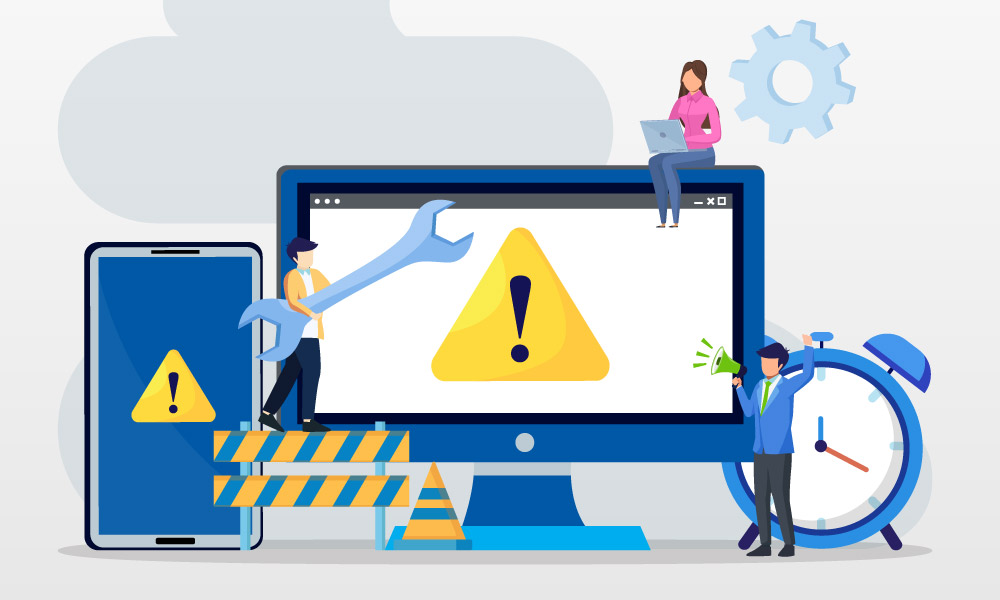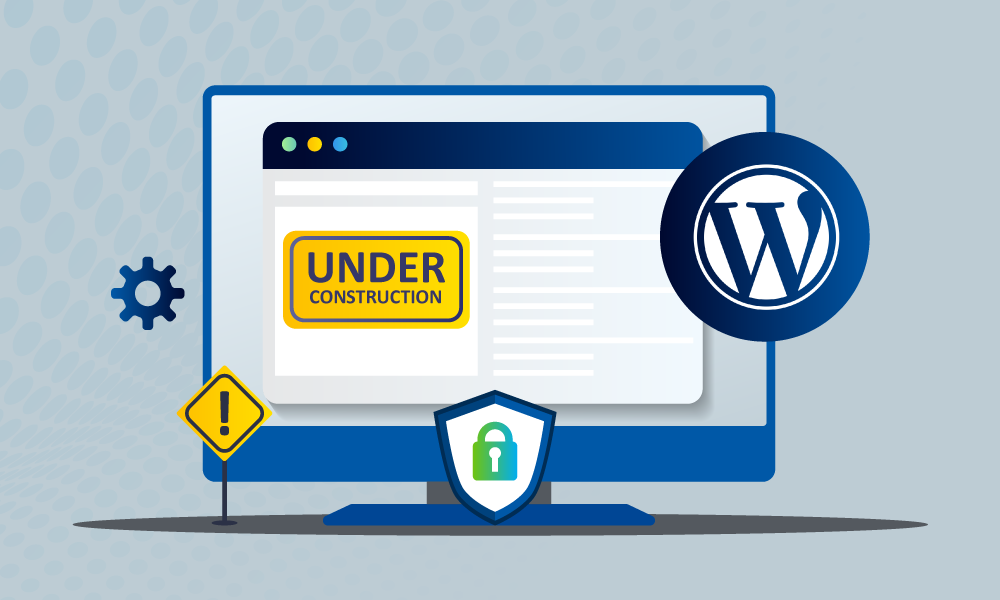B2B Website Design Best Practices You Need to Know
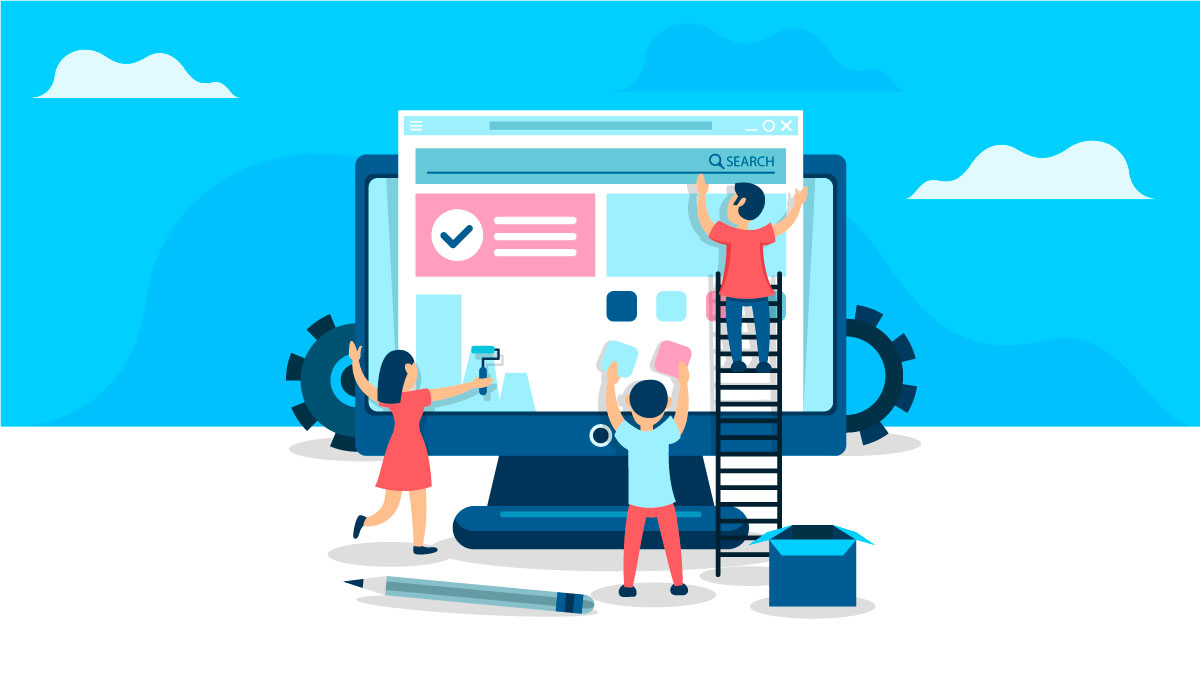
In B2B web design, capturing attention instantly is crucial—research shows it takes only 0.9 seconds for visitors to form an opinion about your website. To make the best impression, each element must serve the buyer’s journey effectively.
A B2B site goes beyond being a simple digital brochure; it’s your brand’s first handshake, setting the tone for trust. By following B2B website design best practices, you can create a visually appealing and professional space that truly resonates.
Discover the best ways to design a site that not only engages but truly guides potential clients forward.
Key Takeaways:
How Do I Create a Good B2B Website?
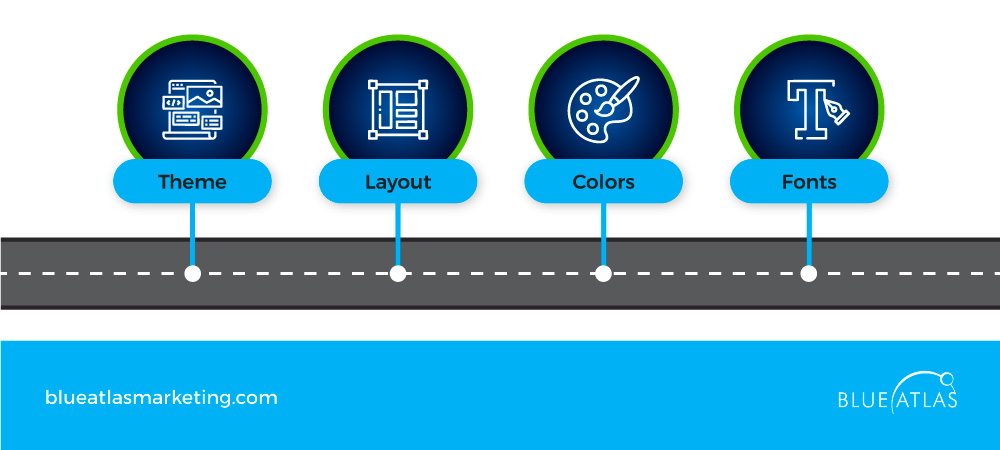
Designing a strong B2B website is part art, part strategy. It’s about balancing creativity with a clear, professional structure that appeals to decision-makers and industry professionals.
Components of an Effective B2B Website
The foundation of a good B2B website lies in its design elements working together seamlessly.
Essential components include a cohesive background theme, carefully chosen fonts, and icons that reflect the brand’s identity.
Color theory, animations, images, and layouts all contribute to the look and feel, which should be professional and tailored to the business audience.
Each element needs to fit like a puzzle piece, creating a visually engaging and organized website that supports rather than distracts from the content.
These design choices aren’t just about aesthetics—they’re about usability and experience.
The right layout effortlessly guides visitors through the content, using a structured flow to communicate key points quickly and effectively.
In B2B design, keeping things clean and straightforward is key; clutter-free pages create a more direct and professional impression, which encourages users to explore further.
The Importance of Planning and Research
A successful B2B website starts long before the design phase—it begins with solid research and planning.
By conducting comprehensive research, defining clear goals, and setting specific guidelines, you can streamline the design process and avoid costly rework down the line.
Effective planning enables teams to communicate better, stay aligned with stakeholder expectations, and focus on creating a user-centered site that meets business goals.
Thorough planning also means understanding your audience deeply.
The more precisely you define your users’ needs, the easier it becomes to design a website that feels intuitive, compelling, and functional right from launch.
B2B Website Design Best Practices (And How to Go Beyond Them)
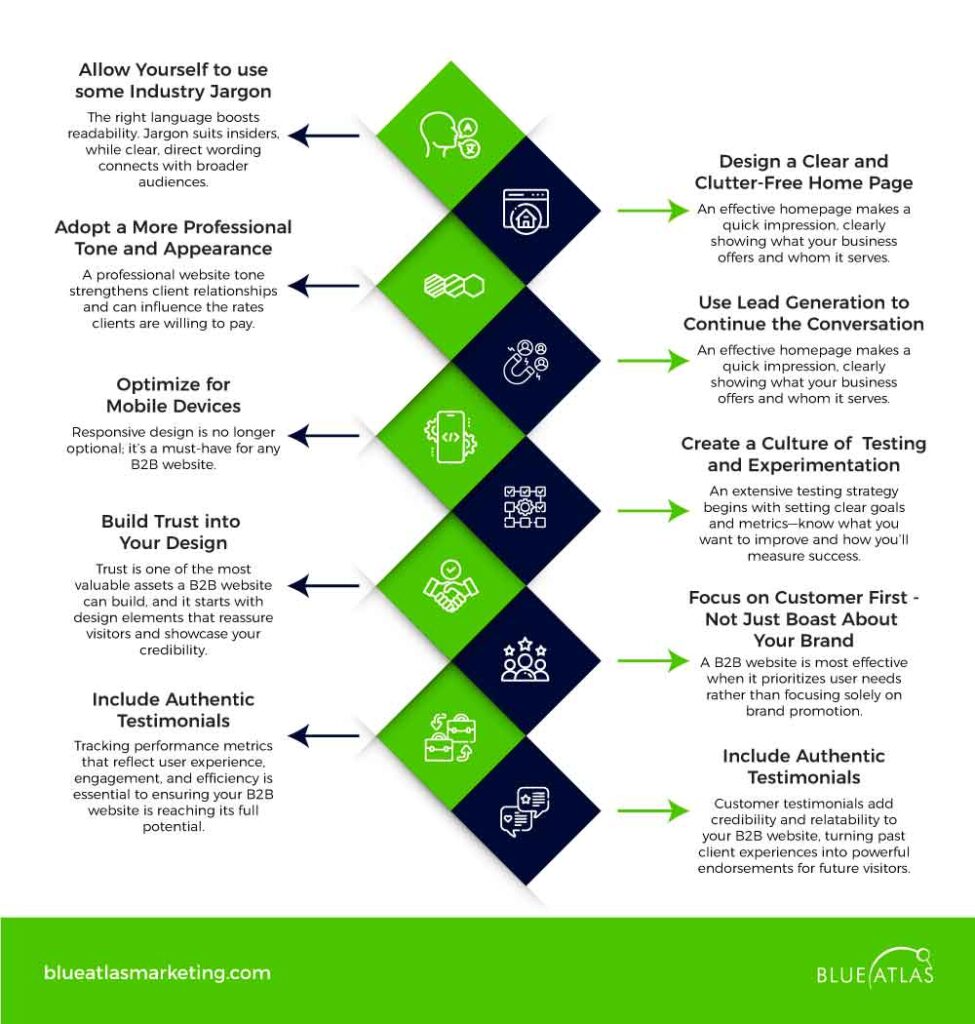
Creating a high-quality website means keeping best practices in mind while remaining open to continuous refinement and adaptation.
A strong B2B website blends design elements that meet user expectations with strategies that encourage exploration.
Start by prioritizing usability, clarity, and visual appeal—essential characteristics that make navigation effortless for users.
Clean layouts, clear headings, and consistent branding work together to shape a professional look and feel, which is critical in B2B.
Since business users are often pressed for time, every second counts and simplicity speak volumes.
Let’s explore the core principles of good design—and some strategies to keep pushing boundaries:
Allow Yourself to use some Industry Jargon
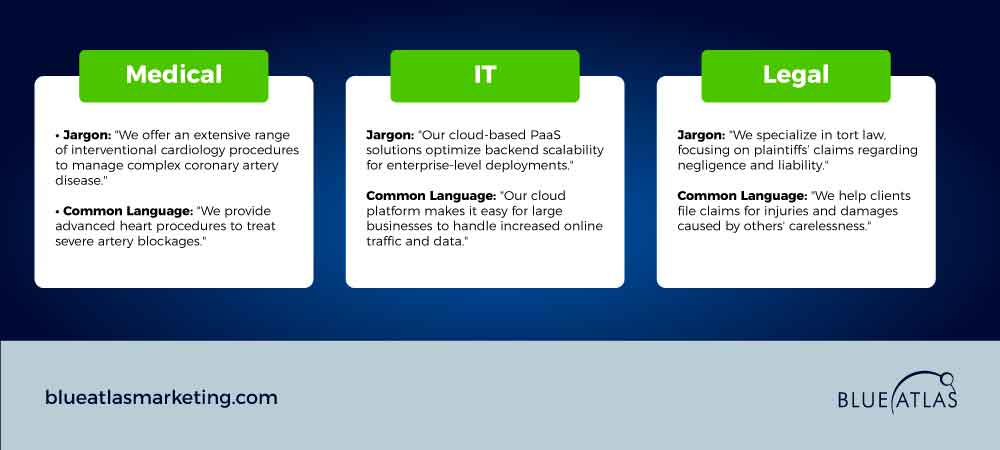
Language is a powerful tool in website design, especially when used strategically to build rapport with your audience.
Jargon, or specialized language, can be an effective way to connect with well-versed audiences in your field.
For example, if your target audience includes industry experts, using precise terms they’re familiar with can reinforce credibility and tailor your messaging.
However, jargon can be a double-edged sword: if misused or overused, it may alienate readers who are less familiar with the language, potentially limiting your reach.
Here’s how jargon might look across different industries:
Medical:
- Jargon: “We offer an extensive range of interventional cardiology procedures to manage complex coronary artery disease.”
- Common Language: “We provide advanced heart procedures to treat severe artery blockages.”
IT:
- Jargon: “Our cloud-based PaaS solutions optimize backend scalability for enterprise-level deployments.”
- Common Language: “Our cloud platform makes it easy for large businesses to handle increased online traffic and data.”
Legal:
- Jargon: “We specialize in tort law, focusing on plaintiffs’ claims regarding negligence and liability.”
- Common Language: “We help clients file claims for injuries and damages caused by others’ carelessness.”
Using the right language enhances readability and connection. For industry insiders, jargon feels familiar and efficient; for broader audiences, keeping it clear and direct opens up access to your message.
This way, everyone stays engaged, and you avoid the risk of losing readers who might not grasp industry-specific language.
Design a Clear and Clutter-Free Home Page
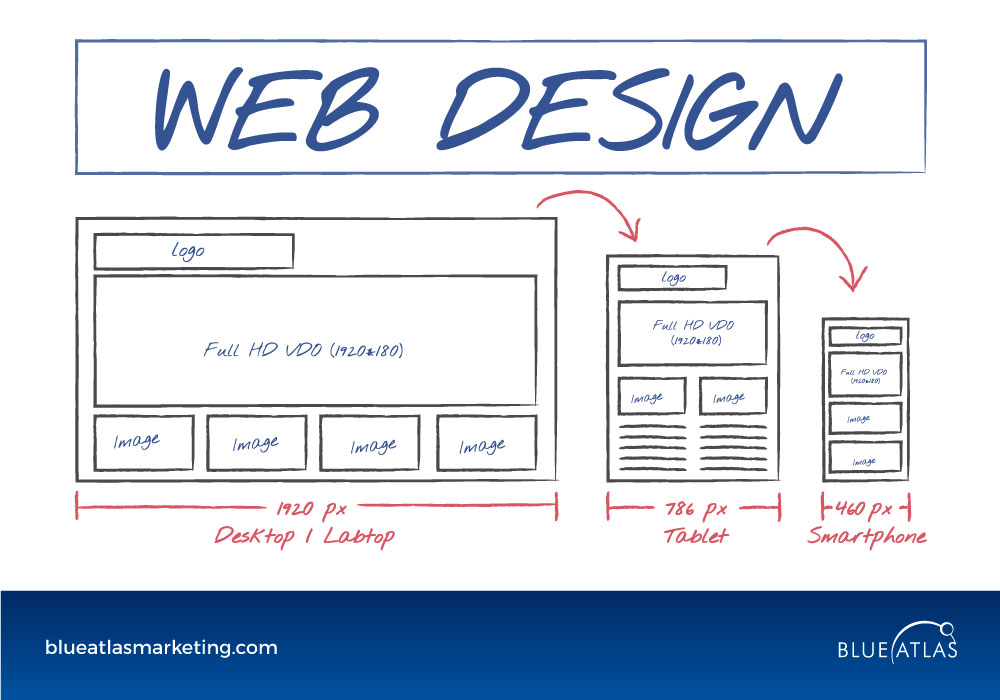
An effective homepage captivates users from the first glance. First impressions happen in less than a second, so clarity is crucial—users should immediately understand what your business offers and who it serves.
Strong brand representation helps anchor this impression; make sure your logo, color palette, and tone align with your company’s identity to instill trust and recognition.
Navigation and direction are equally essential. The homepage should offer a streamlined pathway, making it easy for visitors to find key information or contact options.
Clear and intuitive menus, actionable buttons, and strategic content placement reduce confusion and lead users directly to high-value sections.
Finally, a well-organized website structure enhances usability. By grouping related content and keeping text minimal, you create a clean, professional, optimized homepage to convert visitors into leads.
Adopt a More Professional Tone and Appearance
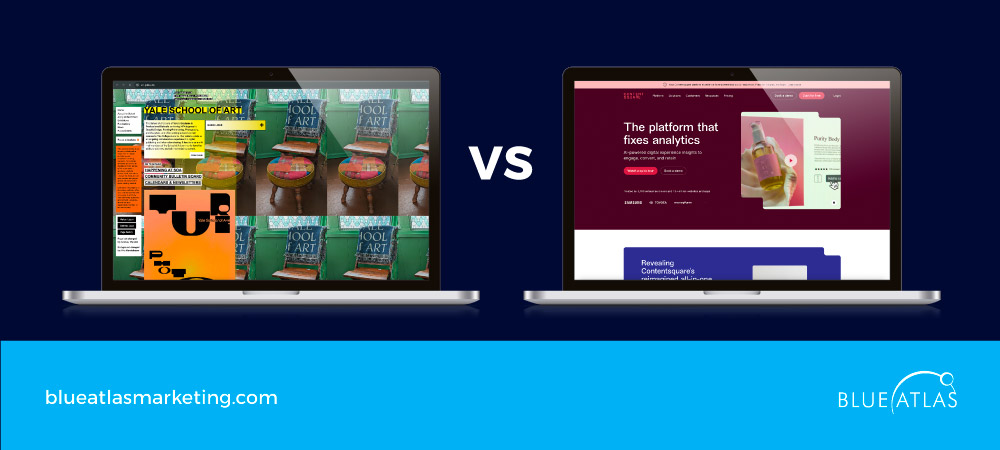
Your website’s professional image significantly shapes how potential clients perceive your business.
When your site looks refined and cohesive, it tells visitors that you’re trustworthy and competent qualities that can influence whether they choose to work with you.
A well-executed design communicates the value of your services and positions you as an industry authority.
The design also affects client perception and engagement.
A clutter-free, visually appealing layout captures attention and reassures users, inviting them to explore further.
When your website is aligned with a professional tone, it supports stronger client relationships and can even impact the rates clients are willing to pay for your expertise.
Use Lead Generation to Continue the Conversation
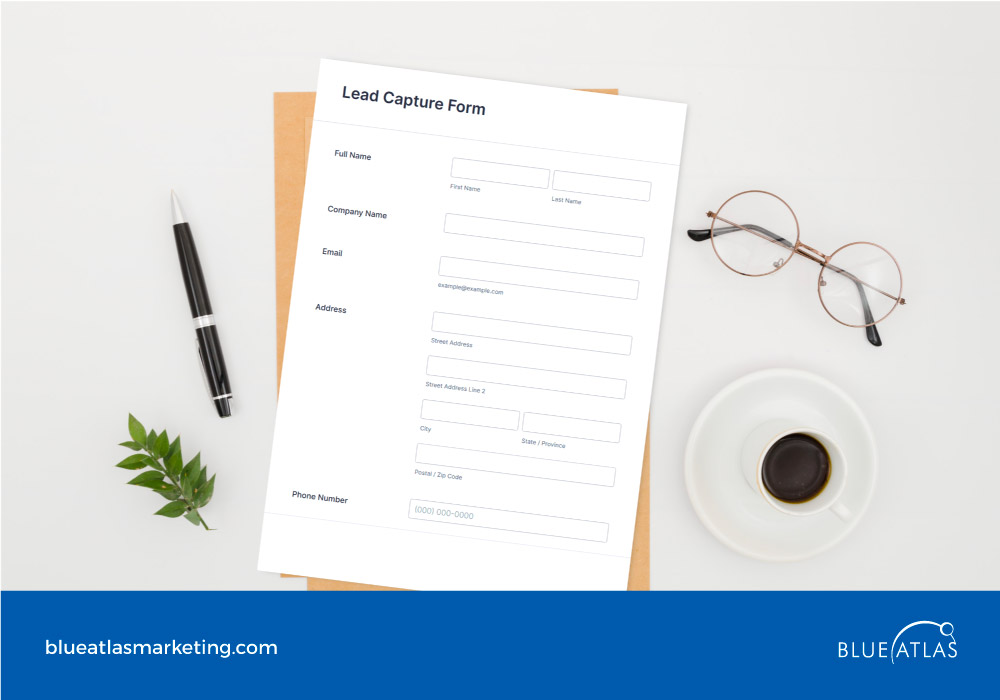
Capturing leads effectively on a B2B website can turn casual visitors into potential clients—if done thoughtfully and strategically:
- Strategic Placement – Position your lead capture form prominently on the page—either above the fold or near key content areas. This visibility helps increase engagement and conversion rates.
- Optimize Form Length – A form that’s too long can deter users. Stick to only the most relevant fields to capture essential information without overwhelming visitors.
- Use Relevant Form Fields – Ensure each field asks for information aligned with your lead nurturing goals. For example, collecting job titles or industry sectors can help tailor follow-up content.
- Privacy Assurance – Including a link to your privacy policy builds trust and reassures users that their information is secure.
- Craft the Submit Button – A customized button (e.g., “Get My Free Guide” instead of “Submit”) makes the interaction feel more personal and engaging.
- Test and Refine – Regular A/B testing can reveal what form lengths, fields, or placements work best, ensuring higher conversion rates.
Optimize for Mobile Devices
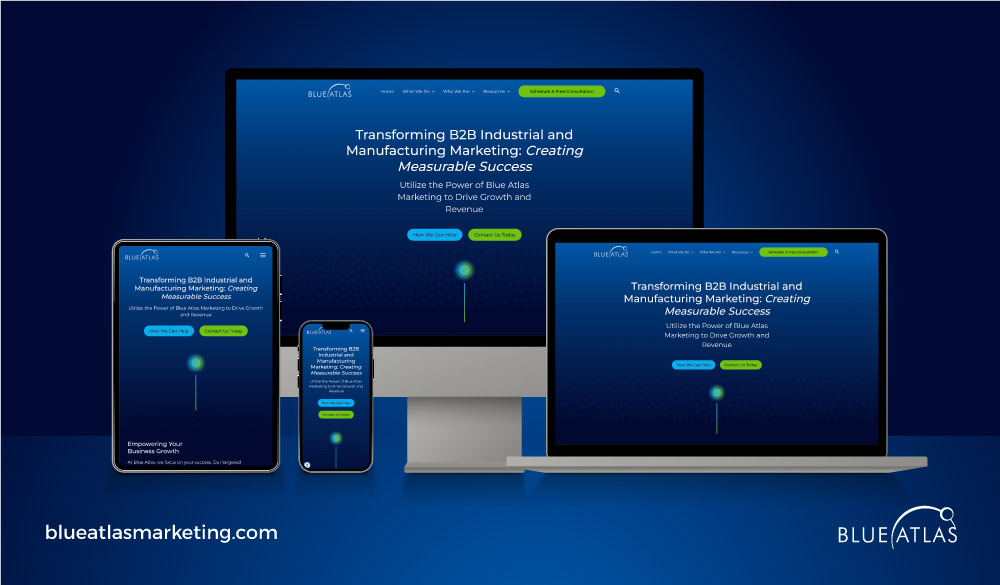
Responsive design is no longer optional; it’s a must-have for any B2B website.
A responsive website adjusts its layout and content dynamically to fit the screen size of the user’s device, be it a smartphone, tablet, or desktop.
This adaptability ensures that every visitor experiences a consistent and user-friendly interface, regardless of device.
The benefits of responsive design go beyond aesthetics.
A responsive website can seamlessly adapt to different screen sizes by using flexible grids, fluid images, and media queries, creating an optimized viewing experience without distorting or misplacing content.
Since business users increasingly rely on mobile devices for work-related research and interactions, a site that’s easy to navigate on mobile is more likely to engage and retain visitors.
Building a great mobile experience goes beyond resizing content:
- A user-centric design approach should focus on simplicity and functionality, ensuring that essential information is accessible without excessive scrolling or pinching.
- Personalization also helps tailor the user journey, using cookies or session data to create a relevant experience.
- Another critical factor is performance and speed. Mobile users quickly abandon slow-loading sites, so optimizing for speed through compressed images, minimized code, and efficient hosting is essential.
- Accessibility and security are also priorities: your mobile site should be accessible to all users, including those with disabilities, and it should provide secure interactions, which are vital in B2B relationships.
With these techniques, your website can deliver a seamless, fast, and secure mobile experience that keeps users engaged across all devices.
Create a Culture of Testing and Experimentation
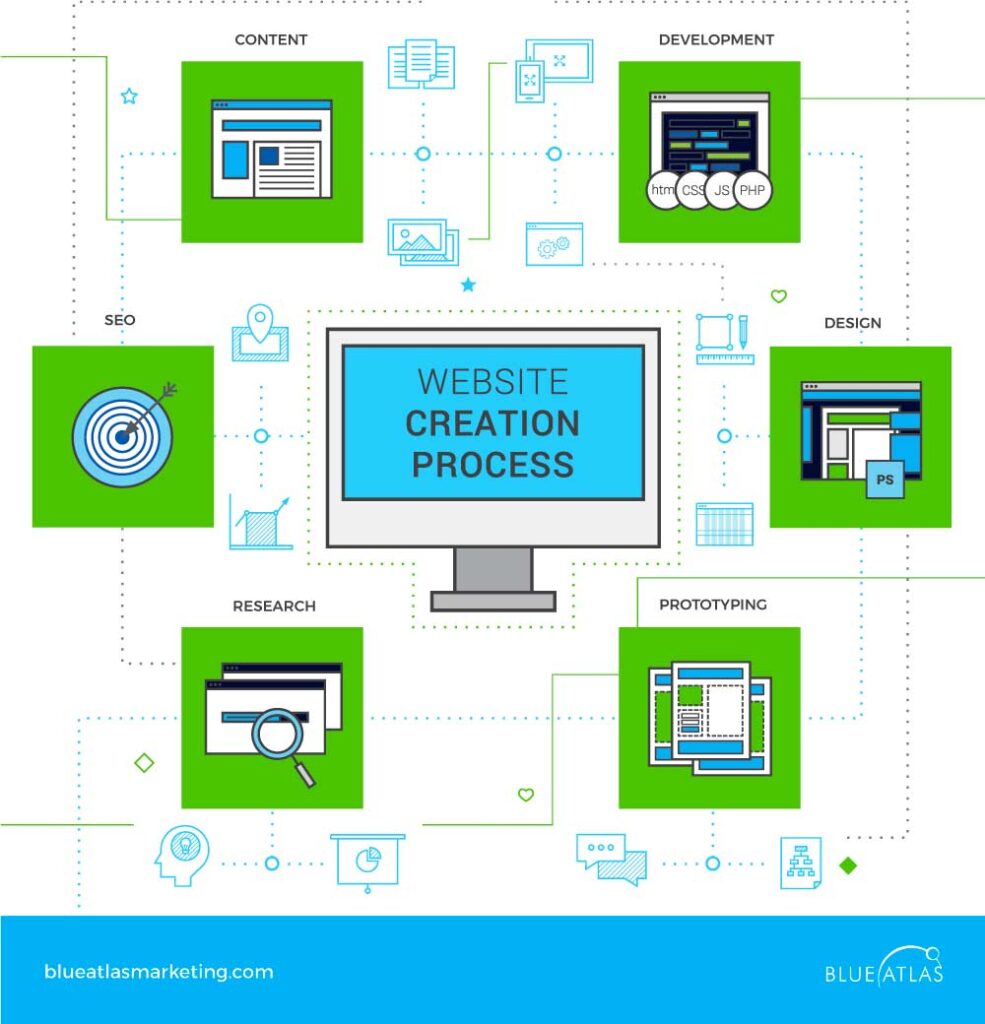
An extensive testing strategy begins with setting clear goals and metrics—know what you want to improve and how you’ll measure success.
For example, if a goal is to increase lead generation, metrics might include conversion rates on lead forms or button clicks.
Next, choose the right methods and tools for your tests. Whether through A/B testing, heatmaps, or usability testing, select methods that align with your objectives
For instance, Spotify frequently uses A/B testing to experiment with new features before a full rollout, gathering data to fine-tune user experience.
To get accurate insights, recruit and segment your users effectively.
For example, a B2B software company could test new features separately with its enterprise clients and smaller businesses, as each group may interact with the site differently.
Once you plan and execute your tests, move quickly to analyze results and iterate based on feedback.
Microsoft’s teams, for instance, are known for conducting frequent tests and continuously improving Office 365’s usability based on user data.
Build Trust into Your Design
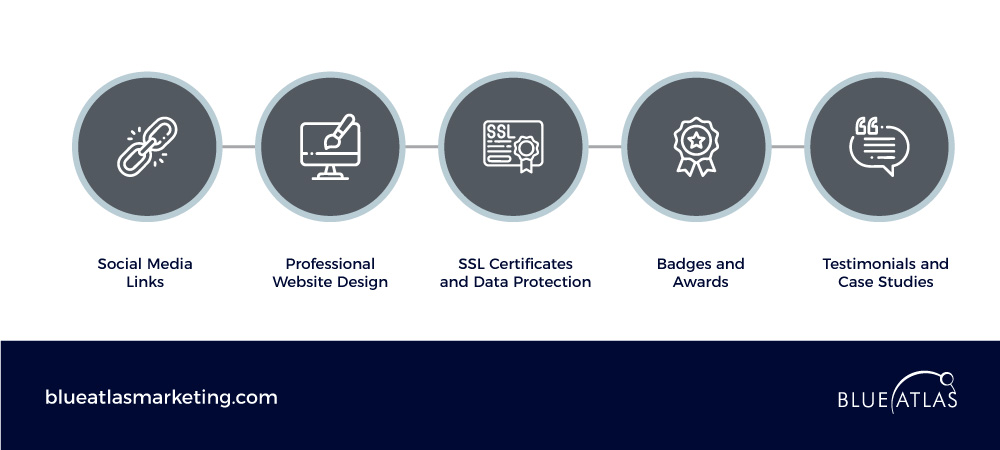
Trust is one of the most valuable assets a B2B website can build, and it starts with design elements that reassure visitors and showcase your credibility.
Social Media Links
- Linking to active and well-maintained social media accounts shows visitors your business is transparent and accessible.
- For example, linking to LinkedIn helps potential clients see company updates, testimonials, and team profiles, reinforcing your legitimacy.
Professional Website Design
- An organized, modern design projects reliability.
- Companies like IBM or SAP maintain clean, well-structured sites, creating an impression of professionalism and stability essential in B2B relationships.
SSL Certificates and Data Protection
- An SSL certificate provides a secure, encrypted connection, especially important for B2B transactions involving sensitive data.
- A secure site marked by “https” assures visitors that your business values privacy and data security.
Badges and Awards
- Displaying certifications or industry awards can instantly boost credibility.
- For instance, a software company that includes a “Trusted by Gartner” badge reinforces quality and trustworthiness.
Testimonials and Case Studies
- Client feedback serves as powerful social proof.
- Featuring testimonials from known brands or case studies detailing successful partnerships, like Adobe’s case studies page, can establish credibility and trust with potential clients.
Focus on Customer First – Not Just Boast About Your Brand
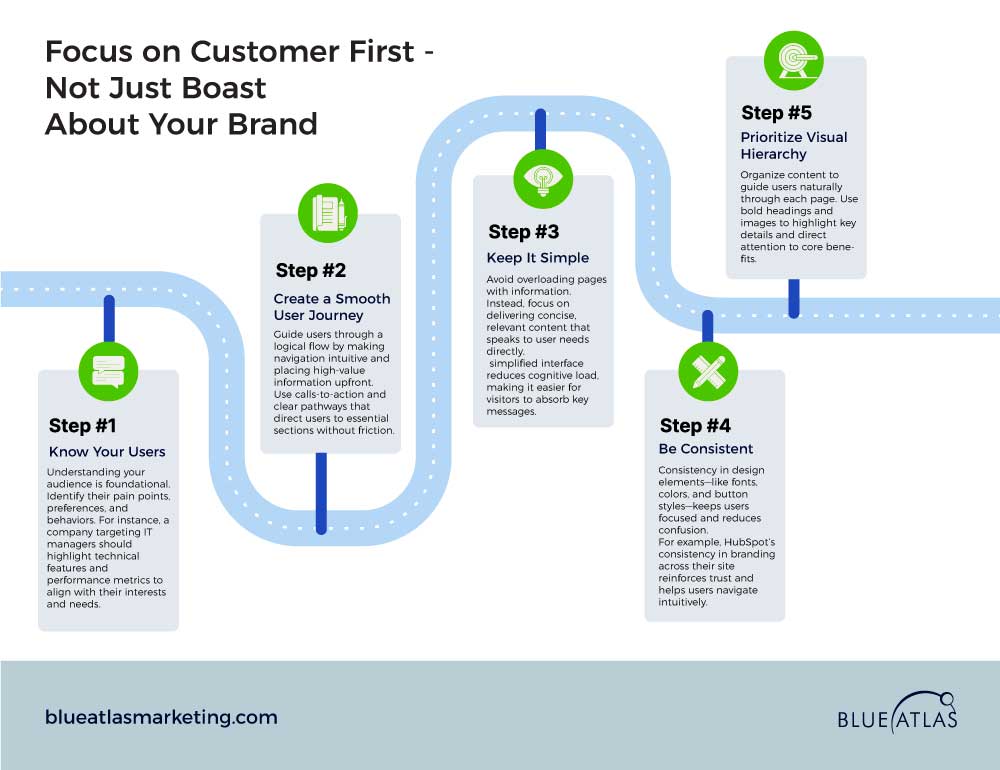
A B2B website is most effective when it prioritizes user needs rather than focusing solely on brand promotion.
Let’s break down the steps to ensure your site is user-centered:
Step 1: Know Your Users
Understanding your audience is foundational. Identify their pain points, preferences, and behaviors.
For instance, a company targeting IT managers should highlight technical features and performance metrics to align with their interests and needs.
Step 2: Create a Smooth User Journey
Guide users through a logical flow by making navigation intuitive and placing high-value information upfront.
Use calls-to-action and clear pathways that direct users to essential sections without friction.
Step 3: Keep It Simple
Avoid overloading pages with information. Instead, focus on delivering concise, relevant content that speaks to user needs directly.
simplified interface reduces cognitive load, making it easier for visitors to absorb key messages.
Step 4: Be Consistent
Consistency in design elements—like fonts, colors, and button styles—keeps users focused and reduces confusion.
For example, HubSpot’s consistency in branding across their site reinforces trust and helps users navigate intuitively.
Step 5: Prioritize Visual Hierarchy
Organize content to naturally lead users through each page. Important details should stand out visually, guiding attention to the information users value most.
Bold headings and images can highlight core benefits and direct focus effectively.
Measure the Success and Performance of Your B2B Website
Tracking performance metrics that reflect user experience, engagement, and efficiency is essential to ensuring your B2B website is reaching its full potential.
| Type of Metric | Definition | Formula | When to Use |
| Core Web Vitals | Measures key aspects of page loading, interactivity, and visual stability | Various, based on Google’s metrics | Regularly; essential for Google ranking and user experience |
| Page Load Metrics | Tracks how quickly a page fully loads for users | Time from request to full load | For understanding page speed and user patience |
| Network Performance Metrics | Evaluates the time taken for network requests and data transfer | Time taken for server requests | To optimize back-end and hosting services |
| Total Page Size | Measures the overall size of a page in kilobytes/megabytes | Sum of all page elements | Helps reduce load times, particularly for mobile users |
| User Patience Index | Assesses how long users will wait before leaving | Time to interact divided by bounce rate | To understand and minimize drop-offs during loading |
| Cache Hit Ratio | Indicates how often cached content is served to users | Cache hits / total requests | For optimizing load speeds, particularly on repeat visits |
| Bounce Rate | Percentage of users leaving after viewing one page | Single-page visits / total visits | For evaluating page relevance and user engagement |
| Average Session Duration | The average time users spend on your site | Total session time / total sessions | To assess engagement and session quality |
| Pages per Session | Average number of pages viewed per session | Total page views / total sessions | Useful for evaluating user journey effectiveness |
| Error Rate | Percentage of requests resulting in errors | Errors / total requests | To monitor and fix technical issues |
| Scroll Depth | Tracks how far users scroll down a page | Scroll distance / page length | For measuring content engagement and visibility |
Include Authentic Testimonials
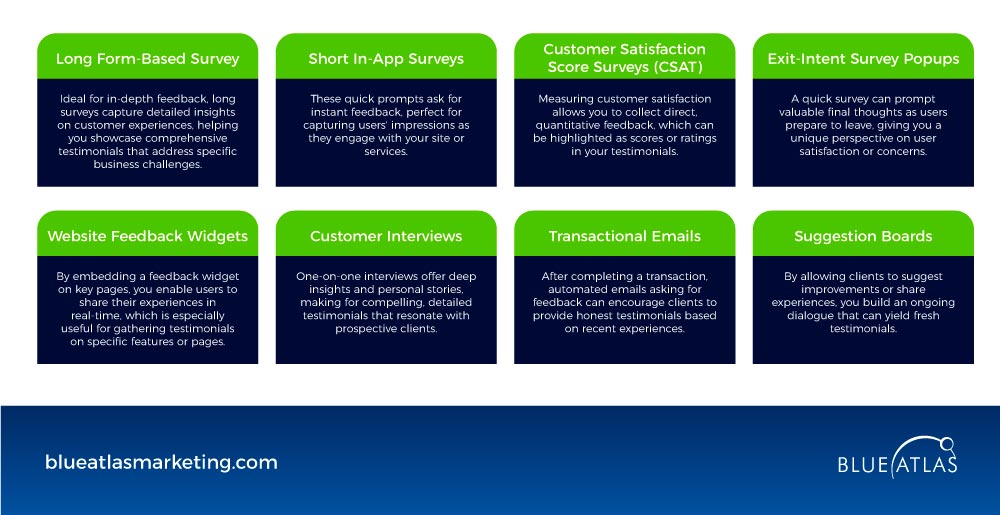
Customer testimonials add credibility and relatability to your B2B website, turning past client experiences into powerful endorsements for future visitors.
Here are some strategies that might help:
- Long Form-Based Survey: Ideal for in-depth feedback, long surveys capture detailed insights on customer experiences, helping you showcase comprehensive testimonials that address specific business challenges.
- Short In-App Surveys: These quick prompts ask for instant feedback, perfect for capturing users’ impressions as they engage with your site or services.
- Customer Satisfaction Score Surveys (CSAT): Measuring customer satisfaction allows you to collect direct, quantitative feedback, which can be highlighted as scores or ratings in your testimonials.
- Exit-Intent Survey Popups: A quick survey can prompt valuable final thoughts as users prepare to leave, giving you a unique perspective on user satisfaction or concerns.
- Website Feedback Widgets: By embedding a feedback widget on key pages, you enable users to share their experiences in real-time, which is especially useful for gathering testimonials on specific features or pages.
- Customer Interviews: One-on-one interviews offer deep insights and personal stories, making for compelling, detailed testimonials that resonate with prospective clients.
- Transactional Emails: After completing a transaction, automated emails asking for feedback can encourage clients to provide honest testimonials based on recent experiences.
- Suggestion Boards: By allowing clients to suggest improvements or share experiences, you build an ongoing dialogue that can yield fresh testimonials.
Frequently Asked Questions (FAQs)
What are the essential elements of B2B website design?
A great example of B2B website design includes clear navigation, responsive design, strong CTAs, trust signals, and professional aesthetics, all playing a vital role in enhancing user experience and supporting business growth.
How can I optimize my B2B website for conversions?
Focus on using concise content, lead capture forms, intuitive navigation, and persuasive CTAs to boost conversions. This approach helps improve SEO and ensures that your website attracts and retains valuable prospects.
Why is mobile optimization crucial for B2B websites?
Mobile optimization ensures a seamless user experience across devices, which plays a vital role in SEO and supports business growth, as more users access websites via mobile devices.
By implementing B2B design best practices, your website becomes a powerful tool that drives results. A focus on clean design, mobile optimization, trust-building elements, and data-driven strategies ensures an engaging user experience that converts visitors into clients.
While perfecting each aspect to suit your business needs can be challenging, the rewards of a well-executed site are invaluable in boosting engagement and achieving lasting success.
Why Blue Atlas Marketing?
Ready to boost your website’s performance?
Our team at Blue Atlas Marketing specializes in B2B web design that drives results, incorporating search engine optimization and interactive elements to captivate your audience. From strategy to implementation, we’ll bring your vision to life.
Contact us today and take the first step toward an engaging, high-performing website!

